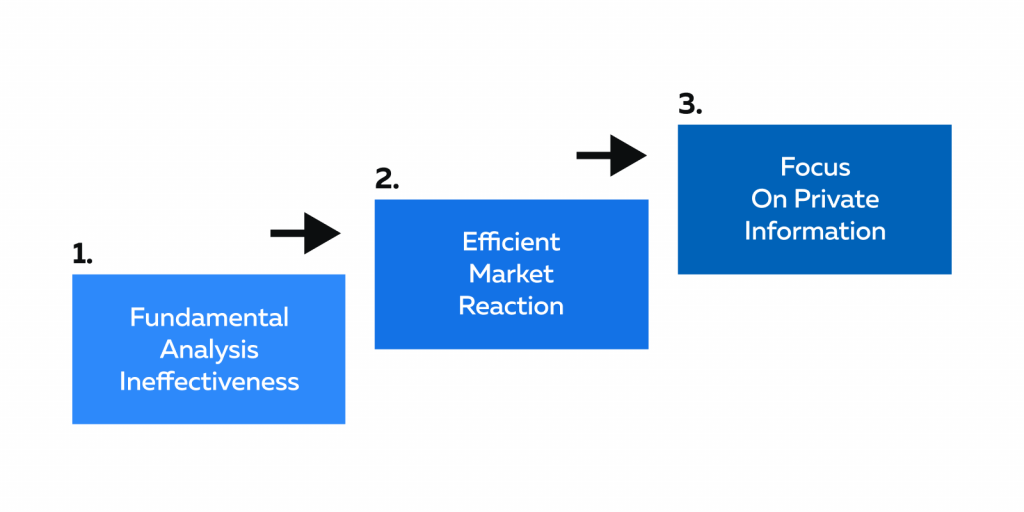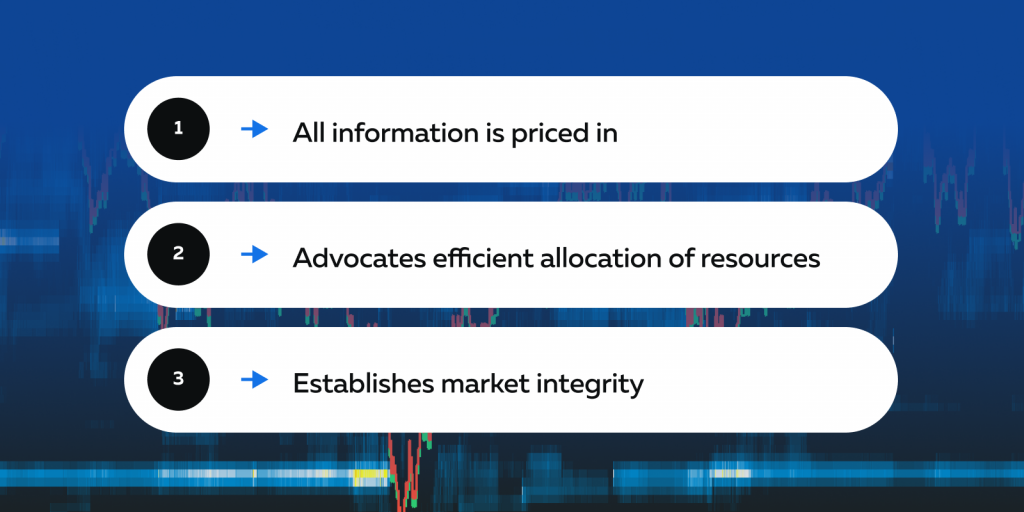

December Trading
Deals Are Live!
Save on Global+, data access,
and add-ons.
See All December Deals

Black Friday
Nov 28-Dec 31
2 days : 8 hours
50% OFF Global+ Quarterly
+ 50% OFF Data (3 months)

Cyber Monday
Dec 1 - Dec 31
2 days : 8 hours
60% OFF Global+ Monthly
+ Data (1 month)

Add-on Deals
Dec 1 - Dec 31
2 days : 8 hours
50% OFF
Add-ons

New Year Sale
Dec 26 - Jan 1
3 days : 8 hours
30% OFF Global+ Lifetime
*Data not included
Education
October 14, 2024
SHARE
Examining Market Efficiency: Efficient Market Hypothesis and Trading Implications

If you’re just starting your exploration journey of market dynamics, you’ve
come to the right place. In this article, we will explore the fundamental
concept of market efficiency and its implications for trading.
We’ll delve into the tiers of market efficiency: Weak, Semi-Strong, and
Strong. This discussion will shed light on their ramifications for traders.
You’ll learn about the challenges you might face when trading in highly
efficient markets and the strategies you can employ to navigate them with
finesse.
Lastly, we’ll also touch on anomalies and patterns that seem to defy market
efficiency and introduce you to the exciting world of behavioral finance.
Are you ready to enhance your market knowledge? Let’s begin!
What is the Efficient Market Hypothesis (EMH)?
The Efficient Market Hypothesis (EMH) asserts two key points:
-
Financial markets operate with a high degree of efficiency.
-
Asset prices fully incorporate all available information.
The central idea behind EMH is that in an efficient market, competition
among investors ensures that information is quickly and accurately reflected
in asset prices. This means that it is extremely difficult for investors to
gain an advantage by:
-
Analyzing past price movements
-
Financial statements
-
Any other publicly available data
But why is this the case?
The core premise is that, at any given moment, the prices of financial
assets, such as stocks or bonds, already encompass all known information.
Consequently, consistently achieving above-average returns through trading
based on publicly available information is deemed unfeasible.
What are the Three Forms of the Efficient Market Hypothesis (EMH)?
Let’s understand their meaning and impact on trading strategies:
|
What are the three forms? |
What do they state? |
How does it affect trading strategies? |
|
Weak Form |
Asset prices already reflect all past trading
|
Technical analysis and the use of past price data to |
|
Semi-Strong Form |
Asset prices incorporate past trading information and
|
The effectiveness of performing either fundamental |
|
Strong Form |
The strong form of EMH proposes that asset prices |
Insider information is of little benefit, as its impact |
As studied above, there are three forms of market efficiency – weak,
semi-strong, and strong. Each one of them has its implications. Let’s
understand them.
Implications of Weak-Form Efficiency
-
Technical Analysis Is Ineffective:
-
Most traders do technical analysis to forecast future price
movements based on historical price patterns, charts, and
indicators. -
According to Weak-Form Efficiency,
-
Technical analysis is ineffective and will not yield excess
returns. -
This is because all historical price data that technical
analysis relies on is already incorporated into the current
market price.
-
-
-
Close Association with Random Walk Theory:
-
Weak-form efficiency is closely associated with the
“random walk” theory
, which suggests that asset prices follow a random and
unpredictable path. -
The asset prices will behave like random walk if – past price
movements do not contain any useful information for predicting
future prices.
-
-
No Heavy Reliance on Past Data:
-
Weak-form efficiency implies that investors must not solely rely
on past trading information for making investment decisions. -
This is because they will not be able to consistently outperform
the market. -
They must consider other factors such as fundamental analysis or
information not yet reflected in market prices.
-
Implications of Semi-Strong Form Efficiency

-
Fundamental Analysis Ineffectiveness:
-
Fundamental analysis involves evaluating an asset’s intrinsic
value based on factors like earnings, financial ratios, and
economic conditions. -
According to Semi-Strong Form Efficiency:
-
Traders performing fundamental analysis will not be able to
produce excess returns because all relevant public
information about a security is already reflected in its
market price. -
They will find it challenging to identify undervalued or
overvalued assets based on publicly available data.
-
-
-
Efficient Market Reaction:
-
Semi-strong form efficiency implies that financial markets react
quickly and efficiently to new information. -
Once news or data is publicized, it swiftly becomes part of
asset prices. -
This leaves minimal room for investors to exploit information
lags or market inefficiencies.
-
-
Emphasis on Private Information:
-
As per Semi-strong form efficiency, investors seeking an
advantage may focus on obtaining private information not yet
publicly available.
-
Implications of Strong-Form Efficiency

-
All Information is Priced In:
-
As per Strong-Form Efficiency, all information, whether it’s
public knowledge or confidential insider information, is already
incorporated into asset prices. -
Actively seeking out private information or relying on insider
tips is unlikely to result in a sustainable competitive edge. -
Instead, investors may opt for passive investment strategies,
such as index funds, which aim to match the overall market
performance.
-
-
Advocates Efficient Allocation of Resources:
-
As per Strong-Form Efficiency, financial markets efficiently
allocate resources and information to the benefit of all
participants. -
Investors do not need to expend significant resources or effort
trying to uncover hidden information or seeking an edge through
insider connections.
-
-
Establishes Market Integrity:
-
From a regulatory perspective, Strong-Form Efficiency
underscores the importance of maintaining market integrity and
preventing insider trading.
-
Trading in an Efficient Market
Trading in highly efficient markets is challenging. The table below
highlights the common challenges faced by the traders and suggestions to
overcome them:
Challenges for Traders in Efficient Markets:
-
Limited Opportunities for Arbitrage: In highly efficient markets,
price disparities due to mispricing or information lags are quickly
corrected. Traders must not try to profit from price discrepancies
as there is little room for arbitrage opportunities. -
High Competition: Efficient markets attract a large number of
informed and professional traders. Due to high competition, traders
must be well-prepared and have access to advanced tools, like
Bookmap, and information to stay competitive. -
Risk of Overtrading: Traders frequently engage in trading in search
of short-term gains, leading to high transaction costs and potential
losses. To avoid overtrading, traders should stick to their
pre-developed backtested strategy and maintain trading discipline.
Navigating Trading Challenges:
Successful trading in efficient markets requires discipline, patience, and a
commitment to ongoing education and improvement. Traders can overcome these
challenges by:
-
Understanding the Form of Efficiency: Traders should determine which
form of market efficiency (Weak, Semi-Strong, or Strong) best
describes their market. This knowledge helps set realistic
expectations regarding trading opportunities. -
Practicing Diversification: Spread investments across various assets
or asset classes to mitigate risks and achieve a more stable
portfolio performance. -
Managing Trading Risk: Set stop-loss orders and position sizing
limits to control potential losses and protect capital. -
Maintaining a Long-Term Perspective: In efficient markets, consider
adopting a long-term perspective. Avoid trying to time the market or
make frequent trades, focusing on long-term investment goals to
weather short-term market volatility. -
Exploring Alternative Strategies: Explore alternative trading
strategies, such as quantitative trading, algorithmic trading, or
options trading, to leverage technology and sophisticated models for
trading opportunities in efficient markets. -
Continuous Learning: Markets evolve, and new information is
constantly becoming available. Engage in continuous learning to stay
updated with market developments, trading strategies, and emerging
trends.
Market Efficiency vs. Real-World Trading

While the Efficient Market Hypothesis (EMH) suggests that markets are highly
efficient and that anomalies should not exist, real-world trading often
reveals patterns and behaviors that challenge perfect market efficiency.
Behavioral finance sheds light on the psychological factors that contribute
to market inefficiencies, while tools and platforms like Bookmap provide
traders with real-time insights to navigate these complexities. Let’s
discuss further.
Anomalies and Patterns in Real-World Trading
Despite the Efficient Market Hypothesis (EMH), real-world markets often
exhibit anomalies and patterns that appear to contradict the idea of perfect
efficiency.
Some common examples include:
-
The January Effect: Stocks often exhibit superior performance in
January. -
The Momentum Effect: Stocks that have previously performed well tend
to continue their streak. -
Value Investing Strategies: Traders consistently gravitate towards
undervalued stocks.
These anomalies suggest that markets may not always be perfectly efficient.
Behavioral Finance and Market Inefficiencies
Behavioral finance emphasizes the role of cognitive biases and psychological
factors that influence investor decision-making. Several biases can lead to
irrational trading decisions and create market anomalies, such as:
-
Overconfidence
-
Herding behavior
-
Loss aversion
Utilizing Market Analysis Tools
While anomalies and inefficiencies may exist, traders must exercise caution.
Even if a pattern or anomaly appears to contradict market efficiency, it may
not persist. Advanced tools like Bookmap provide traders with:
-
Real-time insights into market dynamics
-
Visual representations of order book data
-
Display of the distribution of buy and sell orders at different
price levels
This information helps traders identify support and resistance levels,
detect sudden shifts in supply and demand, and make more informed trading
decisions.
Integration of Machine Learning and AI
Machine learning algorithms and artificial intelligence are increasingly
used by traders and investors to analyze large datasets and identify
patterns or trading opportunities that may not be immediately apparent to
human traders. These technologies possess the adaptability to respond to
shifting market conditions and continuously refine trading strategies.
Conclusion
Understanding market efficiency is paramount for traders when formulating
effective trading strategies. Recognizing the level of efficiency in a
market, whether weak, semi-strong, or strong, imparts valuable insights into
the potential for discovering trading opportunities and aids in setting
realistic expectations.
Given that markets are dynamic and conditions evolve, traders must maintain
a continuous commitment to education and adapt their strategies based on
evolving market conditions.
Access to advanced market analysis tools, like Bookmap, provides a
competitive edge and helps in making informed trading decisions. Wondering
how to apply these insights on market efficiency to your trading strategy?
Dive deeper and
learn how to backtest your trading strategy effectively with our
comprehensive guide
.